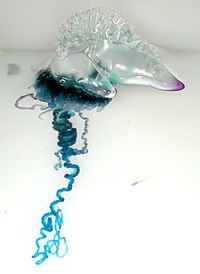
Photo from wikipedia
In this paper, we present the morphology, taxonomy, anatomy, and palynology of Papaver somniferum. A detailed morphological description and illustrations of the species are provided, along with information about the… Click to show full abstract
In this paper, we present the morphology, taxonomy, anatomy, and palynology of Papaver somniferum. A detailed morphological description and illustrations of the species are provided, along with information about the identification, distribution, cultivation areas, habitats, pollinators, specimens examined, growing periods, phenology, etymology, vernacular name, and uses. The species can be characterized as a glabrous and glaucous herb with unlobed or pinnately lobed leaves, and an amplexicaul base; variations in color and morphological characteristics of petals; and white filaments, occasionally purple with a white basal part, broadened at the apical part. Two rings of discontinuous and widely spaced collateral vascular bundles are recognized in the transverse section of the stems. The shape of epidermal cells on the adaxial surface is polygonal, while that on the abaxial surface is polygonal or irregular. The anticlinal cell walls of the epidermal cells on the adaxial surface are straight or slightly curved, while those on the abaxial surface are straight, slightly curved, sinuate, or strongly sinuate. The stomata are anomocytic and are confined to the lower epidermis. The stomatal density is 54–199/mm2 (with a mean of 89.29 ± 24.97). The mesophyll is not distinctly differentiated into palisade and spongy regions. Laticifers are found in the phloem areas of the stems and leaves. The pollen grains can be spheroidal or prolate spheroidal in shape, sometimes oblate spheroidal [polar axis (P) diameter/equatorial axis (E) diameter ratio = 0.99–1.12 (with a mean of 1.03 ± 0.03)]. The pollen aperture is tricolpate and the exine sculpturing is microechinate.
Journal Title: Plants
Year Published: 2023
Link to full text (if available)
Share on Social Media: Sign Up to like & get
recommendations!